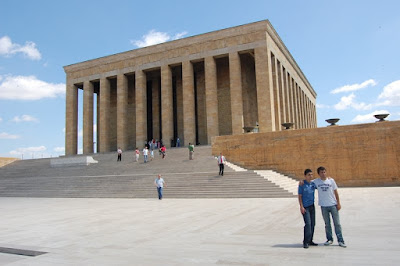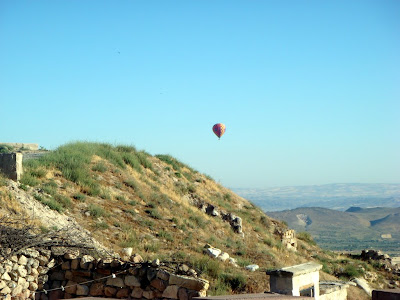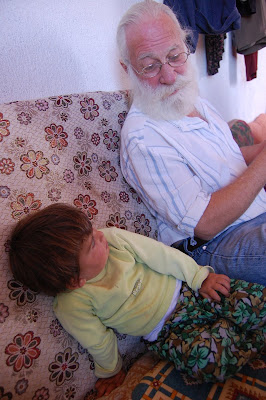
After gathering at our last meeting point in Cappadocia, we got on the ever-crowded Fez bus. We managed to stuff all our bags and ourselves onto it and set off for Ankara. The ride was eventful in and of itself - every so often the bus driver, Mustafa, would swerve across the three lanes of highway we were on. At one point, he was tailgating some poor guy on a moped - the bus was literally 2 meters away from him. I was asleep when the main commotion started, but soon the sounds of yelling and screaming came to the back of the bus. By this time - 12:45 am, we were 45 minutes past the time we were supposed to arrive at Ankara, and everyone was starting to wonder what was going on. The story eventually made it back to us that the bus driver had missed the first Ankara exit. When Prof Shields and the Fez tour guide saw this, they told him to take the next exit. He refused and purposefully missed all the exits for the city. He then started screaming in Turkish to the poor tour guide, saying that he had not been told to get off at Ankara and that he was going to refuse. The twelve of us were frantic because we had to stop, but Mustafa seemed to be on a mission to get back to Istanbul, 7 hours away. After ten minutes of yelling, the bus driver finally got off and turned around. All the Americans and Kiwis and Australians were still tense from the experience so all of us were still watching the road when Mustafa turned right at a sign that stated Ankara was to the left. In the middle of getting off on this wrong exit ramp, Mustafa realized what he did and stopped the bus, then put it in reverse as cars honked and zoomed past us. Then we got into Ankara and he stopped on the shoulder of the highway to ask for directions - at that point, Prof Shields had had enough and told us to unload. It was quite a scene, all twelve Americans with all their baggage on the shoulder of the highway at 1 in the morning. Thanks to Yekta, we managed to get off the bus alive and got three taxis to take us to Bilkent University on the outskirts of the city. We thought it was all funny, another Turkish mystery, but we're lucky it ended well.
In any case, we got to the dorms at 1:30 and were divided into rooms - the guys stayed at one dorm and the girls in another. Bilkent University is a private university that uses English as its primary language - from what we understood, it had 15,000 students. The campus itself wasn't very centralized, though, so we didn't really get the sense that we were at a university in the American sense of the word. The dorms were nice but the rooms tiny - it's a wonder how all the Turkish students put up with it for 4 years.
Now that you've been briefed on the journey to Ankara, a little information about the city itself. Ankara is located on the crossroads of ancient north-south and east-west trade routes. For thousands of years it was an important trade post. Its importance decreased significantly and by the 20th century it was a town of 30,000 people. During the war of independence, Ataturk decided to make Ankara the headquarters of the movement. When the Turkish Republic was established in 1923, Ataturk decided to shy away from making Istanbul - the obvious choice - the capital of the new country because the old Ottoman monuments, palaces and mosques would be too much of a reminder of the Ottoman and Islamic days and hinder the success of the new republic. Ataturk instead selected the sleepy town of Ankara as the capital and immediately set upon building the new capital.
Now, Ankara is a bustling city of more than 4 million people and the political, if not cultural, capital of Turkey. The section of the city as it was during Ataturk's time - Old Ankara - is far superseded by New Ankara, a city that was purposefully built as a secular counterpart to Istanbul. The result was wide boulevards, parks, organized city centers and a generally bland city that lacks the character Istanbul has.
The first day we decided to take day trip to Gordion, a two hour bus ride from Ankara. Gordion was the capital of the Phrygian kingdom, which flourished several thousand years ago. Ken Sands, a UNC professor, happened to actually excavate at the site and led us around:

 Quiz: who is the most famous of the Phrygians? You'd never guess. You know King Midas, as in the King Midas who could touch anything and turn it into gold? He was the king of the Phrygians. This mound of earth was reported to be his tomb:
Quiz: who is the most famous of the Phrygians? You'd never guess. You know King Midas, as in the King Midas who could touch anything and turn it into gold? He was the king of the Phrygians. This mound of earth was reported to be his tomb:
Inside the earth tomb is a simple wooden building which is the oldest known woodest construction known to man.
 The tomb is now actually considered to be that of Gordion, Midas' father.
The tomb is now actually considered to be that of Gordion, Midas' father.We visited the local museum there and then went back to Ankara. At the bus station, Amanda and I decided to try some Cheetos, only to find that there were not only cheese cheetos but a whole shelf-full of different flavors:
 I was conservative and stuck with the cheese, but Amanda got some yogurt flavored ones. Delicious.
I was conservative and stuck with the cheese, but Amanda got some yogurt flavored ones. Delicious.Once back there, we decided to go get something to eat and then headed to a bar to watch the final game of the Eurocup between Germany and Spain - I was pulling for Germany, but Spain ended up pulling it out. We got a tower of Efes:

We also visited Kocatepi Mosque, which is one of the largest mosques in the world. It was huge and very nice inside, and even though it was only built in 1992 it compared to the Blue Mosque back in Istanbul:


The chandelier was ra-dik-ulus:
 The second day, we were taken around Antikabir - Attaturk's burial place. It was like the Lincoln Memoria but even more grand in scale:
The second day, we were taken around Antikabir - Attaturk's burial place. It was like the Lincoln Memoria but even more grand in scale:
The Man's tomb:


While we were there, a procession of politicians, military generals, businessmen, girl scouts, and taekwondo practicers came in and laid a wreath on the tomb. It is standard practice for any visiting diplomat and for Turkish politicians to lay wreaths whenever they came to the capital; there's a whole process to it.
In the afternoon, we went to the Museum of Anatolian Civilizations, one of the preeminent museum of pre-Greek and Roman civilizations. They had cave paintings more than 5000 years old:

After that, we got a hotel room for Clayton and Kristina who were feeling bad - Kristina got food poisening from some sketchy looking cig kofte. The rest of us went to dinner at the Ottoman house, which had a nice view of the city.
After dinner, we all headed to the train station. After the experience with the Fez bus, we decided it wouldn't be a good idea to take that back to Istanbul. Instead, we went on the Midnight Train to Istanbul - it sounds like an Agatha Christie novel. Here's pictures of people in the compartments:


The people that were doing alright decided to have a darty in our train compartment. It was crazy. At one point, Edward pretended to be a BBC reporter, and at another we danced on top of the train cushions. 'Twas fun.

 The train pulled into Hayderpasa station at about 7:30 am the next morning. Needless to say, we were all exhausted from the trip and ready to be back at home.. er.. Istanbul. It's good to be back.
The train pulled into Hayderpasa station at about 7:30 am the next morning. Needless to say, we were all exhausted from the trip and ready to be back at home.. er.. Istanbul. It's good to be back.













































